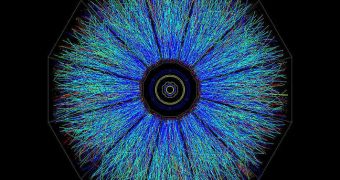The Big Bang is at this point the most widely accepted theory on the beginning of the Universe. It states that everything around us, plus dark matter and dark energy, emerged from a singularity, a powerful event that took place about 13.7 billion years ago. While its outcome is largely known today, as in the galaxies, black holes, stars and planets of the Universe, what the early state of the Cosmos was just millionths of a second after the Big Bang is still unknown. All physicists do know is that a very strange state of matter called quark-gluon plasma existed just from a fraction of a fraction of a second after the initial explosion, PhysOrg reports.
Researchers from nine research institutions in the United States have recently entered a five-year, theoretical collaboration effort, whose express goal is to investigate the QGC. The “Quantitative Jet and Electromagnetic Tomography of Extreme Phases of Matter in Heavy-Ion Collisions” (JET) initiative is being led by the US Department of Energy's (DOE) Lawrence Berkeley National Laboratory (Berkeley Lab). Researchers here were deemed by the DOE Office of Nuclear Physics as the most qualified to guide this research effort. According to physicists, it is widely believed that the quark-gluon plasma condensed immediately after appearing into protons, neutrons, as well as a host of other elementary, subatomic particles, that are known today as making up the Universe.
Experts at the DOE Brookhaven National Laboratory (BNL), using the Relativistic Heavy Ion Collider (RHIC) device, managed to produce QGP again, more than 13.7 billion years after it disappeared from the Universe. “One of the main discoveries at RHIC is that the quark-gluon plasma produced in heavy-ion collisions behaves as a perfect fluid with very small viscosity,” Berkeley Lab Nuclear Science Division (NSD) Nuclear Theory Group senior scientist Xin-Nian Wang says. He is also the project director of the JET Collaboration. The scientist adds that the goal of this investigation is to determine the exact nature of the strong interactions that take place between the loosely-bound gluons and quarks inside QGP.
At this point, the alloted budget for this research stands at about $2.5 million. In addition to working on establishing more data of this type of plasma theoretically, the team members will also be working closely with experimentalists, train students and postdoctoral fellows, in order to train the next generation of high-energy physicists at the same time. The Lawrence Livermore and Los Alamos national labs are also involved in these experiments, as are the Columbia, Duke, McGill, Ohio State, Purdue and Texas A&M.

 14 DAY TRIAL //
14 DAY TRIAL //